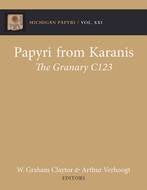KARANIS: MULTIDISCIPLINARY APPROACHES TO AN EGYPTIAN TOWN
This project, funded by a UM Humanities Collaboratory Development Grant, unites researchers to study the ancient village of Karanis in Egypt from multidisciplinary perspectives. This village, excavated by the University of Michigan between 1924 and 1935 is one of the best documented archaeological sites from the Roman world. Tens of thousands of the finds (artifacts and texts) are present on the University of Michigan campus, as well as thousands of documents, maps, and photographs produced during the excavations. These data have previously been studied in a piecemeal fashion. The Development Grant will permit a holistic approach to data from two structures, C65 and C137. A long-term goal is the creation of the Karanis Research Portal, an online discovery tool containing digitized maps, plans, artifact records, photographs excavation notebooks, and other records in the University’s archives. We envision the Research Portal as a tool that could be used by scholars, by students in undergraduate or graduate classes, and, due to the popularity of both archaeology and ancient Egypt, by the general public.
Discarded, Discovered, Collected: The University of Michigan Papyrus Collection
This book, accepted for publication by the University of Michigan Press, provides an introduction to the papyrus collection of the University of Michigan, its history, contents, and contributions to scholarship. Central to the book are images of about 60 items (papyri, ostraca, waxed tablets, parchment, leather) that show the chronological and thematic breadth of the collection and that illustrate various aspects of life in the ancient world.

University of Michigan Press, October 2017.
Papyri from Karanis: The Granary C123 (P.Mich. XXII)
This volume, co-edited with W. Graham Claytor, with the assistance of Paul Heilporn and Samantha Lash, contains the editions of several papyri that were all found in one of the main granaries of Roman Karanis, identified as C123 by the excavators. All texts are part of the papyrus collection of the University of Michigan. An introduction that details the excavation process of C123 during three seasons (1928-1931) with the help of archival photographs from the Kelsey Museum of Archaeology brings to the fore the many problems that modern scholars face in trying to make sense of the Karanis excavations. Many of the texts were prepared by graduate students from the University of Michigan Department of Classical Studies and Interdepartmental Program in Greek and Roman History, as part of a graduate seminar.
Village elites between Ptolemaic and Roman Rule (ACLS Fellowship 2008)
Abstract:
This project, based on detailed analysis of papyrus documents, describes the various strategies that local elites used to hold on to power in the changing social circumstances of the transition from Ptolemaic to Roman rule in Egypt. It shows how the two parts that made up the village elites in the Ptolemaic period (one “Egyptian,” the other “Greek”) responded in various ways to the new, legally defined, and precisely termed way in which the Romans measured class and status, which was completely different from how these had been measured under Ptolemaic rule.
The House of Claudius Tiberianus: Text and Context
Abstract:
This project consists of a detailed material analysis of House B/C 167 in Roman Karanis. This house was the findspot for the famous letters from Terentianus to his father Tiberianus (P.Mich. 8 467-481). Analysis of the excavation records has shown that there were sixteen texts more found in the same locus (a cubby hole under the stairs). These texts will be published, and put in their archaeological and historical context.
Literature:
R.P. Stephan – A. Verhoogt, ‘Text and Context in the Archive of Tiberianus (Karanis, Egypt; 2nd century AD),’ BASP 42 (2005), 189-201. Full text here.
Dictating Letters in Greek and Roman Egypt from a comparative perspective
Abstract:
This project analyzes the social practice of dictating letters in ancient Egypt by comparing it with the process of dictating letters in Mali, West Africa.


